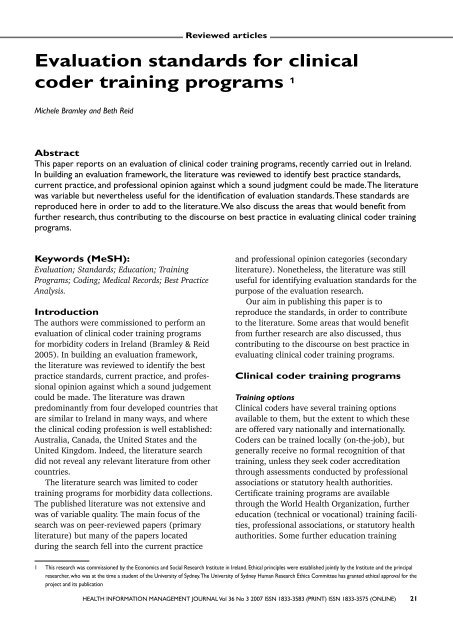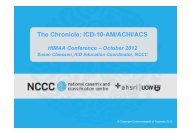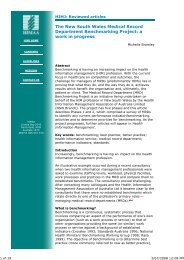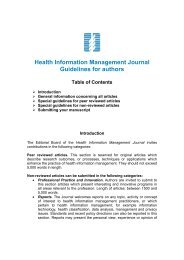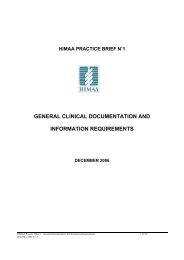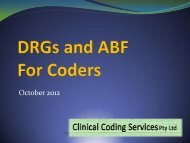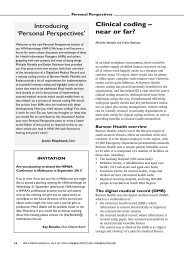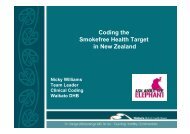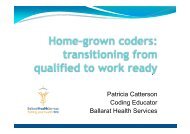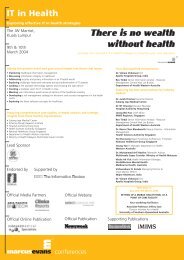Evaluation standards for clinical coder training programs 1 - Health ...
Evaluation standards for clinical coder training programs 1 - Health ...
Evaluation standards for clinical coder training programs 1 - Health ...
Create successful ePaper yourself
Turn your PDF publications into a flip-book with our unique Google optimized e-Paper software.
Reviewed articles<br />
<strong>Evaluation</strong> <strong>standards</strong> <strong>for</strong> <strong>clinical</strong><br />
<strong>coder</strong> <strong>training</strong> <strong>programs</strong> 1<br />
Michele Bramley and Beth Reid<br />
Abstract<br />
This paper reports on an evaluation of <strong>clinical</strong> <strong>coder</strong> <strong>training</strong> <strong>programs</strong>, recently carried out in Ireland.<br />
In building an evaluation framework, the literature was reviewed to identify best practice <strong>standards</strong>,<br />
current practice, and professional opinion against which a sound judgment could be made. The literature<br />
was variable but nevertheless useful <strong>for</strong> the identifi cation of evaluation <strong>standards</strong>. These <strong>standards</strong> are<br />
reproduced here in order to add to the literature. We also discuss the areas that would benefi t from<br />
further research, thus contributing to the discourse on best practice in evaluating <strong>clinical</strong> <strong>coder</strong> <strong>training</strong><br />
<strong>programs</strong>.<br />
Keywords (MeSH):<br />
<strong>Evaluation</strong>; Standards; Education; Training<br />
Programs; Coding; Medical Records; Best Practice<br />
Analysis.<br />
Introduction<br />
The authors were commissioned to per<strong>for</strong>m an<br />
evaluation of <strong>clinical</strong> <strong>coder</strong> <strong>training</strong> <strong>programs</strong><br />
<strong>for</strong> morbidity <strong>coder</strong>s in Ireland (Bramley & Reid<br />
2005). In building an evaluation framework,<br />
the literature was reviewed to identify the best<br />
practice <strong>standards</strong>, current practice, and professional<br />
opinion against which a sound judgement<br />
could be made. The literature was drawn<br />
predominantly from four developed countries that<br />
are similar to Ireland in many ways, and where<br />
the <strong>clinical</strong> coding profession is well established:<br />
Australia, Canada, the United States and the<br />
United Kingdom. Indeed, the literature search<br />
did not reveal any relevant literature from other<br />
countries.<br />
The literature search was limited to <strong>coder</strong><br />
<strong>training</strong> <strong>programs</strong> <strong>for</strong> morbidity data collections.<br />
The published literature was not extensive and<br />
was of variable quality. The main focus of the<br />
search was on peer-reviewed papers (primary<br />
literature) but many of the papers located<br />
during the search fell into the current practice<br />
and professional opinion categories (secondary<br />
literature). Nonetheless, the literature was still<br />
useful <strong>for</strong> identifying evaluation <strong>standards</strong> <strong>for</strong> the<br />
purpose of the evaluation research.<br />
Our aim in publishing this paper is to<br />
reproduce the <strong>standards</strong>, in order to contribute<br />
to the literature. Some areas that would benefit<br />
from further research are also discussed, thus<br />
contributing to the discourse on best practice in<br />
evaluating <strong>clinical</strong> <strong>coder</strong> <strong>training</strong> <strong>programs</strong>.<br />
Clinical <strong>coder</strong> <strong>training</strong> <strong>programs</strong><br />
Training options<br />
Clinical <strong>coder</strong>s have several <strong>training</strong> options<br />
available to them, but the extent to which these<br />
are offered vary nationally and internationally.<br />
Coders can be trained locally (on-the-job), but<br />
generally receive no <strong>for</strong>mal recognition of that<br />
<strong>training</strong>, unless they seek <strong>coder</strong> accreditation<br />
through assessments conducted by professional<br />
associations or statutory health authorities.<br />
Certificate <strong>training</strong> <strong>programs</strong> are available<br />
through the World <strong>Health</strong> Organization, further<br />
education (technical or vocational) <strong>training</strong> facilities,<br />
professional associations, or statutory health<br />
authorities. Some further education <strong>training</strong><br />
1 This research was commissioned by the Economics and Social Research Institute in Ireland. Ethical principles were established jointly by the Institute and the principal<br />
researcher, who was at the time a student of the University of Sydney. The University of Sydney Human Research Ethics Committee has granted ethical approval <strong>for</strong> the<br />
project and its publication<br />
HEALTH INFORMATION MANAGEMENT JOURNAL Vol 36 No 3 2007 ISSN 1833-3583 (PRINT) ISSN 1833-3575 (ONLINE) 21
Reviewed articles<br />
facilities will also offer diploma <strong>programs</strong>; these<br />
are found predominantly in the United States.<br />
Degrees in <strong>Health</strong> In<strong>for</strong>mation Management 2 ,<br />
of which <strong>clinical</strong> coding is a core component,<br />
are available through universities in Australia,<br />
Canada and the United States. <strong>Health</strong> In<strong>for</strong>mation<br />
Managers can choose to specialise in <strong>clinical</strong><br />
coding, or in the management of coding services<br />
and staff within a health care facility. The difference<br />
between the two professions (<strong>clinical</strong> coding<br />
and <strong>Health</strong> In<strong>for</strong>mation Management) is that the<br />
<strong>Health</strong> In<strong>for</strong>mation Management degree further<br />
extends the person’s skills and knowledge in<br />
the areas of in<strong>for</strong>mation management science<br />
(the economics of in<strong>for</strong>mation and the design,<br />
implementation and management of in<strong>for</strong>mation<br />
systems); health in<strong>for</strong>matics (in<strong>for</strong>mation and<br />
communications technology and its application,<br />
integration and implementation); management<br />
(leadership, planning, human resources,<br />
financial); and research (research methods and<br />
analytical skills).<br />
Course curricula<br />
Curricula <strong>for</strong> <strong>clinical</strong> <strong>coder</strong> <strong>training</strong> <strong>programs</strong> are<br />
very similar internationally in the area of fundamental<br />
nosological skills and knowledge. Where<br />
they differ is in the different health care legislative<br />
and regulatory frameworks in each country.<br />
As one illustration, in the United States morbidity<br />
coding is mandated <strong>for</strong> physicians’ offices,<br />
outpatient settings, and inpatient facilities, and<br />
<strong>clinical</strong> <strong>coder</strong>s apply many different morbidity<br />
and casemix classification systems <strong>for</strong> reporting<br />
and reimbursement across the various settings.<br />
The health legislative and regulatory environment<br />
is complex and there are stringent state and<br />
national compliance audit <strong>programs</strong> in place to<br />
detect and deter fraudulent claims <strong>for</strong> reimbursement,<br />
the outcomes of which can be punitive<br />
(Hanna 2002).<br />
In Australia however, morbidity coding is<br />
mandated only <strong>for</strong> inpatient settings. Clinical<br />
<strong>coder</strong>s apply only two classification systems<br />
<strong>for</strong> reporting and funding purposes, one <strong>for</strong><br />
morbidity and one <strong>for</strong> casemix. The health<br />
2 Each country has variations in the titles of the degrees. For simplicity in<br />
description in this paper, we will apply ‘health in<strong>for</strong>mation management’<br />
generically to refer to the degree <strong>programs</strong> in Canada, The United States and<br />
Australia.<br />
legislation and regulatory environment is less<br />
complex than in the United States. State and<br />
territory health authorities conduct audits, but<br />
generally not on a routine basis (Australian<br />
Institute of <strong>Health</strong> and Welfare 2003; 2005) and<br />
the outcomes are educative, rather than punitive.<br />
Thus, a model curriculum <strong>for</strong> <strong>coder</strong> <strong>training</strong><br />
<strong>programs</strong> in the United States will have only<br />
partial relevance in Australia, and vice versa.<br />
The American <strong>Health</strong> In<strong>for</strong>mation<br />
Management Association (AHIMA) (2005b;<br />
2005c) has developed foundation documents <strong>for</strong><br />
a model curriculum. Although the model relates<br />
to <strong>Health</strong> In<strong>for</strong>mation Management, the intention<br />
is that it be used to also guide the development<br />
of curricula <strong>for</strong> <strong>clinical</strong> <strong>coder</strong> <strong>training</strong> <strong>programs</strong>.<br />
Indeed, the World <strong>Health</strong> Organization’s core<br />
curriculum <strong>for</strong> morbidity <strong>coder</strong>s (Skurka &<br />
Walker 2005) is largely based on the American<br />
model. The US curriculum is built from competency<br />
<strong>standards</strong> (AHIMA n.d.; 2005a; 2005b;<br />
2006b), and this premise was consistent in the<br />
scant literature on curriculum design <strong>for</strong> <strong>coder</strong><br />
<strong>training</strong> <strong>programs</strong> offered in Australia, Canada<br />
and the United Kingdom (Canadian <strong>Health</strong><br />
In<strong>for</strong>mation Management Association 2006;<br />
<strong>Health</strong> In<strong>for</strong>mation Management Association<br />
of Australia 1996; Institute of <strong>Health</strong> Record<br />
and In<strong>for</strong>mation Management 2002; Mitchell<br />
1997/1998; Roberts 2000). Another consistent<br />
premise in the literature cited above was that<br />
assessment is competency-based.<br />
Competency based assessment<br />
Assessments based on competency provide<br />
credible and tangible evidence of an individual’s<br />
skills (Mitchell 1997/1998). Assessment<br />
outcomes <strong>for</strong> <strong>coder</strong> <strong>training</strong> <strong>programs</strong> were not<br />
easy to determine from the limited literature,<br />
particularly <strong>for</strong> the degree <strong>programs</strong>. In general<br />
terms, it seems that <strong>coder</strong> certification <strong>programs</strong><br />
assessed competency on a pass/fail basis, while<br />
degree <strong>programs</strong> assessed competency on a<br />
graded basis. This distinction seems to be reflective<br />
of industry expectations that an employee<br />
is either competent or not competent (Clinton,<br />
Murrells & Robinson 2005; Mitchell 1997/1998),<br />
or higher education facilities approaches to<br />
assessment that there are discernable levels of<br />
competence (AHIMA 2005a; Clinton, Murrells &<br />
22 HEALTH INFORMATION MANAGEMENT JOURNAL Vol 36 No 3 2007 ISSN 1833-3583 (PRINT) ISSN 1833-3575 (ONLINE)
Reviewed articles<br />
Robinson 2005; Fink 2003; Rethans et al. 2002;<br />
Sadler 2005).<br />
Internationally, there is variation in the<br />
minimum pass marks set <strong>for</strong> the <strong>coder</strong> certification<br />
<strong>programs</strong>: 60% in Canada (Canadian<br />
<strong>Health</strong> In<strong>for</strong>mation Management Association<br />
2006), 65% in the United States (AHIMA<br />
2006c), 80% in Australia (<strong>Health</strong> In<strong>for</strong>mation<br />
Management Association of Australia 2006), and<br />
90% in England (Institute of <strong>Health</strong> Record and<br />
In<strong>for</strong>mation Management 2002). There is also<br />
variation in assessment methods (Smith 2006),<br />
and the mix of practical and theoretical components<br />
in assessments. Theoretical components<br />
tested recall and knowledge through multiple<br />
choice questions, short answer questions or short<br />
essays. Practical components tested per<strong>for</strong>mance<br />
in application of the classification by coding case<br />
studies or <strong>clinical</strong> records.<br />
Clinical <strong>coder</strong> continuing education<br />
Professional development activities<br />
Professional development activities specifically<br />
related to coding, such as updates in medical<br />
science, refresher <strong>training</strong> courses, workshops,<br />
seminars, conferences, and <strong>coder</strong> accreditation,<br />
generally fall to the professional associations,<br />
with some activities offered by national regulatory<br />
bodies, state health authorities, and health<br />
care facilities.<br />
National and state activities<br />
In Australia, the National Centre <strong>for</strong> Classification<br />
in <strong>Health</strong> conducts workshops <strong>for</strong> <strong>clinical</strong> <strong>coder</strong>s,<br />
in association with the Clinical Coders’ Society of<br />
Australia, be<strong>for</strong>e the release of an updated edition<br />
of the morbidity classification (McKenzie et al.<br />
2004; Roberts 2000). The <strong>Health</strong> In<strong>for</strong>mation<br />
Management Association of Australia (HIMAA)<br />
provides professional development activities and<br />
accreditation of <strong>clinical</strong> <strong>coder</strong>s (HIMAA 2006).<br />
The Open Training and Education Network<br />
(2003), a further education facility, also provides<br />
opportunities <strong>for</strong> entry-level and continuing<br />
education 3 .<br />
3 Certifi cate courses in coding and medical terminology <strong>for</strong> those <strong>coder</strong>s who<br />
received their initial <strong>training</strong> on the job, or entry level <strong>training</strong> <strong>for</strong> others who<br />
are interested in a change of career, <strong>for</strong> example nurses who wish to become<br />
<strong>clinical</strong> <strong>coder</strong>s.<br />
In England, the National <strong>Health</strong> Service is<br />
the primary body that provides certified <strong>training</strong><br />
courses, <strong>coder</strong> accreditation, and continuing<br />
education activities <strong>for</strong> <strong>clinical</strong> <strong>coder</strong>s, in partnership<br />
with the Institute of <strong>Health</strong> Record and<br />
In<strong>for</strong>mation Management, the certifying body<br />
(National <strong>Health</strong> Service 2005). In the United<br />
States, professional development activities<br />
are offered through professional associations,<br />
accredited colleges, universities, and commercial<br />
<strong>training</strong> companies (McKenzie et al. 2004).<br />
Local activities<br />
Initiatives conducted at the local level (health<br />
care facilities) are often described as in-house<br />
educational activities and support the on-thejob<br />
<strong>training</strong> or continuing education of <strong>clinical</strong><br />
<strong>coder</strong>s. Coder orientation or residency <strong>programs</strong><br />
provide <strong>coder</strong>s with support and additional<br />
<strong>training</strong> as they build their experience (Carol<br />
2004; Featheringham 2005; Groom 2003;<br />
Thomson & Koch 1999). Over a dedicated<br />
timeframe, <strong>coder</strong>s are oriented to the facility,<br />
local practices, policies, regulations and guidelines,<br />
and slowly build their skills. A coding<br />
mentor regularly assesses the new <strong>coder</strong>’s competency<br />
and provides advice. In building skill levels,<br />
a principal strategy involves the division of work,<br />
where the new <strong>coder</strong> becomes proficient in one<br />
<strong>clinical</strong> specialty at a time, beginning with simple<br />
cases and progressing to more complex cases<br />
(Groom 2003; Haggarty & Ives 2005; Wooding<br />
2004).<br />
Creating the position of an in-house educator<br />
or building a team of in-house educators that<br />
includes <strong>clinical</strong> staff, is a positive measure to<br />
improve the competency of coding staff (Carol<br />
2004; Groom 2003; Logan, O’Neill & Martin<br />
2003; McKenzie & Walker 2003: 114; Stavely<br />
2000; Stegman 2003; Thomson & Koch 1999).<br />
In-house educators can act as mentors, auditors,<br />
and analysts, and provide continuing education<br />
to all hospital staff about the coding function and<br />
the benefits of using the data produced. They can<br />
also act as a clinician liaison to solve coding and<br />
<strong>clinical</strong> documentation issues.<br />
Local <strong>training</strong> initiatives were found to be<br />
beneficial in four ways. First, these initiatives<br />
help to determine a new <strong>coder</strong>’s potential.<br />
External measures of coding skills are made inde-<br />
HEALTH INFORMATION MANAGEMENT JOURNAL Vol 36 No 3 2007 ISSN 1833-3583 (PRINT) ISSN 1833-3575 (ONLINE) 23
Reviewed articles<br />
pendent of the working environment (Mitchell<br />
1997/1998), however, it is just as important to<br />
assess competency in the workplace, <strong>for</strong> it is only<br />
through ongoing assessment that the potential<br />
of a new <strong>coder</strong> can be determined. There is little<br />
point in expending time and ef<strong>for</strong>t into <strong>training</strong><br />
someone who turns out to be unsuitable <strong>for</strong> the<br />
task (Logan, O’Neill & Martin 2003). Second, a<br />
<strong>coder</strong>’s career path can be built on local <strong>training</strong><br />
initiatives. Through experience and professional<br />
development, <strong>coder</strong>s can progress to become<br />
analysts and educators (Carol 2004). Third, local<br />
<strong>training</strong> initiatives can be certified by regulatory<br />
bodies or professional associations; certification<br />
is an endorsement that trainees have met<br />
certain <strong>standards</strong>. The more professional development<br />
credentials coding staff have increases<br />
their employment opportunities (Scichilone &<br />
Mackenzie 2006), and also raises stakeholder<br />
confidence in the quality of the data they produce<br />
(Thomson & Koch 1999). Finally, these initiatives<br />
effectively involve the local level in <strong>training</strong><br />
initiatives and share some of the responsibility<br />
<strong>for</strong> <strong>coder</strong> <strong>training</strong> (Canadian Institute <strong>for</strong> <strong>Health</strong><br />
In<strong>for</strong>mation 2003; Cook 1998).<br />
Accreditation or program<br />
approval of <strong>Health</strong> In<strong>for</strong>mation<br />
Management/<strong>clinical</strong> <strong>coder</strong> <strong>training</strong><br />
<strong>programs</strong><br />
An accreditation or program approval process<br />
provides an indicator of the quality of a program<br />
to prospective learners. In the United States, the<br />
process of accreditation <strong>for</strong> <strong>Health</strong> In<strong>for</strong>mation<br />
Management undergraduate degree <strong>programs</strong> is<br />
exacting. Accreditation must be gained through<br />
a candidacy process which can take up to two<br />
years and then maintained on a yearly basis<br />
through a body established <strong>for</strong> that purpose,<br />
the Commission on Accreditation <strong>for</strong> <strong>Health</strong><br />
In<strong>for</strong>matics and In<strong>for</strong>mation Management<br />
Education (CAHIIM) (AHIMA 2005b; CAHIIM<br />
2006a). CAHIIM also conducts the review process<br />
and grants approval, rather than accreditation,<br />
<strong>for</strong> the graduate level <strong>Health</strong> In<strong>for</strong>mation<br />
Management degree <strong>programs</strong>. Approval is<br />
granted <strong>for</strong> a period of five years when <strong>standards</strong><br />
are met (CAHIIM 2006b).<br />
For certificate level <strong>coder</strong> <strong>training</strong> <strong>programs</strong>,<br />
AHIMA conducts the review process and grants<br />
approval, rather than accreditation, <strong>for</strong> a period<br />
of five years when <strong>standards</strong> are met. Seeking<br />
program approval is voluntary. Competencies are<br />
the basis <strong>for</strong> all <strong>standards</strong> (AHIMA 2005b).<br />
The Canadian <strong>Health</strong> In<strong>for</strong>mation<br />
Management Association (CHIMA) approves<br />
<strong>coder</strong> <strong>training</strong> <strong>programs</strong>, but explanations about<br />
the process and the <strong>standards</strong> are cursory at best<br />
(CHIMA n.d.; McKenzie et al. 2004). The <strong>Health</strong><br />
In<strong>for</strong>mation Management Association of Australia<br />
(HIMAA) (2003) accredits <strong>Health</strong> In<strong>for</strong>mation<br />
Management degree <strong>programs</strong>. Accreditation is<br />
awarded <strong>for</strong> a period of three years if a program<br />
has demonstrated compliance with the competency<br />
<strong>standards</strong> (HIMAA 2001) and the <strong>standards</strong><br />
<strong>for</strong> approval of <strong>programs</strong>. There was no documentation<br />
found addressing accreditation of <strong>coder</strong><br />
<strong>training</strong> <strong>programs</strong> in the United Kingdom.<br />
The World <strong>Health</strong> Organization through its<br />
Family of International Classifications Network 4<br />
has established a working committee to develop<br />
core curricula <strong>for</strong> morbidity <strong>coder</strong> <strong>training</strong><br />
<strong>programs</strong>. The committee also plans to develop<br />
standard criteria <strong>for</strong> assessing educators and<br />
trainers, and a <strong>coder</strong> certification program<br />
(Skurka & Walker 2005). It is notable that the<br />
body responsible <strong>for</strong> developing and maintaining<br />
the statistical disease classification used<br />
worldwide <strong>for</strong> over a century has only recently<br />
developed its core international curriculum <strong>for</strong><br />
<strong>coder</strong> <strong>training</strong> <strong>programs</strong>.<br />
Of all these <strong>programs</strong>, the United States has<br />
the most clearly articulated, transparent and<br />
accessible <strong>standards</strong> <strong>for</strong> core curriculum and the<br />
approval/accreditation process. However, this has<br />
not necessarily translated into the best <strong>training</strong><br />
<strong>programs</strong> on offer. AHIMA voiced its concerns in<br />
a recent presentation, that in some HIM <strong>training</strong><br />
<strong>programs</strong> in the United States ‘… students are<br />
not being taught and/or tested at the appropriate<br />
cognitive level <strong>for</strong> entry-level competency’<br />
(AHIMA n.d.b). To counteract this trend, AHIMA<br />
now provides a number of resources and evaluation<br />
<strong>standards</strong> <strong>for</strong> downloading from its website<br />
4 “WHO has designated a number of collaborating centres to work with it in<br />
the development, dissemination, maintenance and use of the WHO Family<br />
of International Classifications to support national and international health<br />
in<strong>for</strong>mation systems, statistics and evidence” Source: http://www.who.int/classifications/network/en/<br />
(Accessed 28 May 2006).<br />
24 HEALTH INFORMATION MANAGEMENT JOURNAL Vol 36 No 3 2007 ISSN 1833-3583 (PRINT) ISSN 1833-3575 (ONLINE)
Reviewed articles<br />
with the aim of supporting educators in developing<br />
appropriate <strong>training</strong> courses.<br />
<strong>Evaluation</strong> <strong>standards</strong> <strong>for</strong> <strong>clinical</strong><br />
<strong>coder</strong> <strong>training</strong> <strong>programs</strong><br />
The CAHIIM (2005) and AHIMA (2005c; 2006a)<br />
accreditation <strong>standards</strong> that guide the evaluation<br />
of degree based and certification <strong>clinical</strong> <strong>coder</strong><br />
<strong>training</strong> <strong>programs</strong> in the United States take a<br />
goal-based approach to evaluation (AHIMA n.d.a;<br />
Wadsworth 1997) and measure <strong>programs</strong> solely<br />
against their objectives. Key stakeholder input<br />
into the evaluation is not sought.<br />
These <strong>standards</strong> are tools <strong>for</strong> accrediting<br />
<strong>training</strong> <strong>programs</strong> and focus more on the institution<br />
itself and its administrative functions and<br />
there<strong>for</strong>e not all of the <strong>standards</strong> were useful or<br />
appropriate <strong>for</strong> our evaluation research, which<br />
was more focused on curriculum. To compensate,<br />
we supplemented the CAHIIM and AHIMA<br />
<strong>standards</strong> with <strong>standards</strong> drawn from the other<br />
literature available to guide best practice in evaluating<br />
<strong>coder</strong> <strong>training</strong> <strong>programs</strong>, and removed the<br />
<strong>standards</strong> that were not relevant to curriculum.<br />
The <strong>standards</strong> are reproduced in Table 1.<br />
Identifying the <strong>training</strong> needs of<br />
<strong>clinical</strong> <strong>coder</strong>s<br />
Judging by the literature, the needs of <strong>clinical</strong><br />
<strong>coder</strong>s in respect to their <strong>training</strong> are rarely<br />
assessed, there<strong>for</strong>e they have little influence<br />
on the direction their <strong>training</strong> <strong>programs</strong> take.<br />
No independent evaluation of <strong>coder</strong> <strong>training</strong><br />
<strong>programs</strong> is complete unless it includes feedback<br />
from the perspective of <strong>clinical</strong> <strong>coder</strong>s and their<br />
employers or managers about what <strong>coder</strong>s need<br />
or expect from the <strong>training</strong> <strong>programs</strong>.<br />
The only empirical study we found that<br />
identified the <strong>training</strong> needs from the perspectives<br />
of <strong>clinical</strong> <strong>coder</strong>s and their managers was<br />
McKenzie and Walker’s (2003) survey of the<br />
Australian Coder Work<strong>for</strong>ce. For continuing<br />
education, <strong>coder</strong>s prefer face-to-face workshops<br />
or conferences and distance learning (printbased<br />
courses), rather than online learning.<br />
Clinical updates (medical science/surgical procedures)<br />
are ranked high on their list of <strong>training</strong><br />
priorities, but they also want more <strong>training</strong> in<br />
<strong>clinical</strong> terminology, anatomy and physiology,<br />
and coding <strong>standards</strong>. Computing skills, quality<br />
assurance, casemix, and research were also<br />
seen as areas <strong>for</strong> further education (McKenzie &<br />
Walker 2003). Coding managers agreed with the<br />
need <strong>for</strong> broader education <strong>for</strong> <strong>coder</strong>s because<br />
they <strong>for</strong>esaw a greater involvement in casemix<br />
funding, electronic health records (and thus a<br />
need <strong>for</strong> computing skills), quality assurance, and<br />
research. In an increasingly electronic environment,<br />
managers believed that communication<br />
skills would be crucial as <strong>coder</strong>s interacted more<br />
with clinicians (McKenzie & Walker 2003). Other<br />
studies also reflected the importance of communication<br />
skills as <strong>coder</strong>s interact more with<br />
clinicians (MacDonald 1999; Thomson & Koch<br />
1999).<br />
Coders, and their managers, believed that<br />
<strong>coder</strong>s need more opportunities <strong>for</strong> ongoing<br />
education and <strong>training</strong> support throughout their<br />
careers with managers expressing concern at<br />
the lack of external opportunities <strong>for</strong> continuing<br />
education. Almost all managers supported <strong>coder</strong>s’<br />
attendance at external continuing education<br />
activities through funding and time off work<br />
(McKenzie & Walker 2003). Managers did not<br />
compensate <strong>for</strong> the lack of external continuing<br />
education activities by providing local activities.<br />
Less than half of the managers provided internal<br />
continuing education activities. Of those that<br />
did, the majority spent less than 5% of their time<br />
developing or organising activities. Clinical <strong>coder</strong>s<br />
also spend little time on continuing education,<br />
with the majority allocating less than 5% of their<br />
time to their continuing education (McKenzie &<br />
Walker 2003).<br />
Almost 40% of <strong>coder</strong>s surveyed believed<br />
their <strong>training</strong> was inadequate in preparing them<br />
<strong>for</strong> the work<strong>for</strong>ce (McKenzie & Walker 2003).<br />
Coders thought that some of the coding scenarios<br />
provided in an educational environment were<br />
very different from the actual <strong>clinical</strong> records<br />
seen in the work environment (McKenzie &<br />
Walker 2003: 85). They believed that they were<br />
inadequately prepared <strong>for</strong> illegible and incomplete<br />
<strong>clinical</strong> records, and how to deal with these<br />
issues in the workplace. The use of de-identified<br />
copies of actual <strong>clinical</strong> records, covering all<br />
<strong>clinical</strong> specialties, and of varying complexity, is<br />
a crucial element of any <strong>coder</strong> <strong>training</strong> program,<br />
as outlined in the evaluation <strong>standards</strong> (AHIMA<br />
2006a; CAHIIM 2005; HIMAA 2003 Appendix: 1).<br />
HEALTH INFORMATION MANAGEMENT JOURNAL Vol 36 No 3 2007 ISSN 1833-3583 (PRINT) ISSN 1833-3575 (ONLINE) 25
Reviewed articles<br />
Table 1: <strong>Evaluation</strong> <strong>standards</strong> <strong>for</strong> <strong>clinical</strong> <strong>coder</strong> <strong>training</strong> <strong>programs</strong><br />
STANDARDS<br />
Program goals and objectives<br />
Program advisory committee<br />
Access, equity and resources<br />
Staffi ng<br />
Curriculum<br />
Assessment<br />
<strong>Evaluation</strong> and monitoring<br />
MEASURES<br />
•<br />
•<br />
•<br />
•<br />
•<br />
•<br />
•<br />
•<br />
•<br />
•<br />
•<br />
•<br />
•<br />
•<br />
•<br />
•<br />
•<br />
•<br />
•<br />
•<br />
•<br />
•<br />
•<br />
•<br />
•<br />
•<br />
•<br />
•<br />
•<br />
•<br />
The program’s goals and objectives must <strong>for</strong>m the basis <strong>for</strong> program planning, implementation and<br />
evaluation.<br />
The program’s goals and objectives must be stated in terms of measurable outcomes.<br />
An advisory committee should be established, with representation from all key stakeholders, to assist<br />
with program evaluation and continuing development (HIMAA 2003).<br />
Committee meetings should be held at least once a year.<br />
Programs should facilitate access to all, particularly those who live in isolated and rural regions.<br />
Flexibility is important to consider <strong>for</strong> those who work full time (Eagar & Innes 1992: 77) or who<br />
have disabling conditions.<br />
Participants should have ready access to resources and facilities that support their study (HIMAA<br />
2003).<br />
Teaching staff must incorporate current knowledge in their curriculum design and should be suitably<br />
qualifi ed. HIMAA (2003: 8) stipulates a minimum of three years professional experience, coupled<br />
with research experience.<br />
Clinicians should be involved in delivering relevant course content, particularly in the biomedical<br />
science subjects (Carol 2004; McKenzie & Walker 2003).<br />
Learning and teaching objectives must demonstrate a relationship to competency <strong>standards</strong> (Eagar &<br />
Innes 1992).<br />
The length of the program should be suffi cient to demonstrate competency. AHIMA (2006a) suggests<br />
approximately 500 contact hours <strong>for</strong> certifi cation <strong>programs</strong> which equates to almost 63 working<br />
days. Stegman (2003) suggests that two to three months (around 44 to 66 working days) is suffi cient<br />
<strong>for</strong> beginning practitioners receiving in-house (hospital) <strong>training</strong>.<br />
Classes should be structured to deliver a mix of didactic and practical sessions.<br />
Innovative teaching methods, such as problem-based learning should be used (Eagar & Innes 1992).<br />
Innovative modes of delivery should be considered, such as on-line learning, distance learning, selflearning,<br />
web-based seminars, intranet, audio conferences (Carol 2004; Eagar & Innes 1992; Roberts<br />
2000).<br />
Professional practice placements in health care facilities should be a part of the program (unless<br />
<strong>training</strong> is supplemented by on-the-job experience).<br />
Manual (books) and automated methods (electronic books, en<strong>coder</strong>s) of coding should be taught.<br />
Course material should be provided to each participant and this material should clearly describe<br />
the course learning objectives, the assessments to be undertaken, the frequency of testing and the<br />
competencies required <strong>for</strong> completion.<br />
Course content should cover: biomedical sciences, basic computing, data abstraction skills, <strong>clinical</strong><br />
coding and classifi cation systems, health care data content and structure, funding methods and<br />
policies, ethical practice, quality assurance (including audits), health care delivery systems, and<br />
relevant legislation and regulations and the legal issues pertaining to them (Eagar & Innes 1992;<br />
HIMAA 2001; Skurka & Walker 2005).<br />
Content should be sequenced appropriately to develop the necessary competencies <strong>for</strong> entry-level<br />
practitioners. For example, foundation subjects such as <strong>clinical</strong> terminology and anatomy should be<br />
taught be<strong>for</strong>e <strong>clinical</strong> coding.<br />
Participants should work with de-identifi ed copies of actual <strong>clinical</strong> records, in addition to workbook<br />
exercises (HIMAA 2003, Appendix: 1). The records should be of a varied casemix and complexity to<br />
provide participants with experience across all <strong>clinical</strong> specialties.<br />
Participants must demonstrate their competency through assessment.<br />
Assessment should be matched to learning objectives.<br />
Assessment tasks should be varied (different types of assessment) and increase in complexity as<br />
participants progress through the program.<br />
The other principles of good practice in assessment (as evidenced by the literature) should be<br />
followed (Fink 2003; Ramsden 2003).<br />
Assessment should be conducted throughout various stages of the program so that participants<br />
receive an indication of their progression through the course (Eagar & Innes 1992; Kirkpatrick 1994).<br />
A monitoring and evaluation plan should be in place.<br />
Program evaluation should be conducted annually.<br />
Measures should include participant per<strong>for</strong>mance, educator per<strong>for</strong>mance, employer satisfaction,<br />
participant satisfaction, yearly attrition rates, national certifi cation scores, and program completion<br />
rates.<br />
Results should be reported in terms of meeting goals and objectives.<br />
Action taken must be documented and reported (Kirkpatrick 1994).<br />
Modifi ed from AHIMA n.d.a; AHIMA 2006a: 9, 20-9; CAHIIM 2005: 2, 3, and supplemented or supported by the references stated in the appropriate sections of the table.<br />
26 HEALTH INFORMATION MANAGEMENT JOURNAL Vol 36 No 3 2007 ISSN 1833-3583 (PRINT) ISSN 1833-3575 (ONLINE)
Reviewed articles<br />
Some <strong>coder</strong>s found their course too basic <strong>for</strong><br />
complex situations encountered in the working<br />
environment, particularly their limited <strong>training</strong><br />
in anatomy and physiology. One <strong>coder</strong> stated: ‘I<br />
learned how to find codes in the coding books,<br />
not how to find the problems in a medical record’<br />
(McKenzie & Walker 2003: 85). They wanted<br />
more practical (‘hands-on’) coding experience<br />
in the course. Their managers supported their<br />
<strong>coder</strong>s here, but focused on the university setting<br />
<strong>for</strong> their criticisms. They noted that graduates<br />
have a lack of <strong>clinical</strong> knowledge, and practical<br />
experience in reading and understanding medical<br />
documentation (McKenzie & Walker 2003).<br />
Discussion<br />
One aspect of our evaluation of <strong>clinical</strong> <strong>coder</strong><br />
<strong>training</strong> <strong>programs</strong> in Ireland explored what is best<br />
practice in evaluating <strong>coder</strong> <strong>training</strong> <strong>programs</strong><br />
(Bramley & Reid 2005). The literature is lacking<br />
in a number of areas and we discuss some of<br />
them here in the hope that further research in this<br />
area will be conducted.<br />
Two areas that are intrinsically linked are<br />
the differences in the length of various <strong>training</strong><br />
<strong>programs</strong> and the differences in course content,<br />
<strong>for</strong> these may well be factors in <strong>coder</strong> competency.<br />
The AHIMA standard <strong>for</strong> the length of<br />
a <strong>coder</strong> <strong>training</strong> program is that it should be<br />
sufficient to demonstrate competency, and they<br />
suggest approximately 500 contact hours (or<br />
63 working days) <strong>for</strong> certification <strong>programs</strong>.<br />
However, we could find no empirical basis <strong>for</strong> the<br />
standard in our search of the literature. Australia,<br />
Canada and the United Kingdom all had different<br />
timeframes <strong>for</strong> their professional association<br />
certification <strong>programs</strong>; 120 hours of study, via<br />
distance, over a 9-12 months period, a 2-day<br />
workshop (14 hours), and a 15 day course (105<br />
hours) respectively. Each country has different<br />
expectations of proficiency (60% in Canada, 75%<br />
in the United States, 80% in Australia, and 90%<br />
in United Kingdom). Only the United States stipulated<br />
the minimum number of hours expected to<br />
be undertaken in the coding component of the<br />
degree based <strong>Health</strong> In<strong>for</strong>mation Management<br />
<strong>programs</strong> (500 contact hours).<br />
Course content obviously underpins the<br />
AHIMA standard, as do the assessments used to<br />
measure competency. Any variation in course<br />
content or measures of competency would erode<br />
the validity of the standard. Our search of the<br />
literature revealed variation internationally in<br />
course content and in the type of assessments<br />
applied to measure competency. Only one peerreviewed<br />
paper described the various assessment<br />
methods used to assess student learning in HIM<br />
educational facilities in the United States (Smith<br />
2006). Smith (2006) also described the extent<br />
to which the <strong>programs</strong> have incorporated the<br />
principles of good practice in assessment, in<br />
their assessment of student learning. However,<br />
Smith’s research did not extend to determining<br />
equivalence between the instruments used <strong>for</strong><br />
assessment, which could then in turn lead to<br />
an evaluation of the effectiveness of the various<br />
assessment methods applied.<br />
Any variation in assessment <strong>standards</strong> makes<br />
it difficult to evaluate whether the higher pass<br />
mark set <strong>for</strong> Australia and England, is indicative<br />
of a more proficient coding work<strong>for</strong>ce, and thus<br />
an indicator of good curriculum design and the<br />
effectiveness of learning and teaching. In educational<br />
institutions, the number of participants<br />
passing the course and participants’ exam scores<br />
infer judgements about the quality of learning<br />
and teaching (AHIMA n.d.a; Hornby 2003). This<br />
is an effective indicator <strong>for</strong> internal use, but it<br />
should be used cautiously when benchmarking<br />
where it is not possible to determine equivalence<br />
between instruments used <strong>for</strong> assessment in<br />
similar courses taught at different educational<br />
facilities. Participants may score highly if simple<br />
coding scenarios or line coding exercises are used<br />
in assessment, and not so well if actual <strong>clinical</strong><br />
records of varying complexity are used. Recall<br />
that <strong>coder</strong>s in Australia took their educators to<br />
task <strong>for</strong> using exercises that are not a valid reflection<br />
of the workplace. Irish <strong>coder</strong>s expressed<br />
similar sentiments in a recent study (Bramley &<br />
Reid 2005).<br />
Research is needed to give substance to the<br />
value of different types of assessments used to<br />
develop and assess coding skills. Specifically,<br />
one project could focus on the coding exercises<br />
applied in assessments and the development of<br />
a complexity scale to grade them appropriately.<br />
Research substantiating AHIMA’s standard <strong>for</strong><br />
the length of <strong>coder</strong> <strong>training</strong> <strong>programs</strong> would<br />
be useful. The literature was also lacking in<br />
HEALTH INFORMATION MANAGEMENT JOURNAL Vol 36 No 3 2007 ISSN 1833-3583 (PRINT) ISSN 1833-3575 (ONLINE) 27<br />
1
Reviewed articles<br />
measuring the degree to which participants<br />
learn and the extent to which participants apply<br />
what they learnt in the <strong>training</strong> program to their<br />
workplace (transferance).<br />
Also of benefit would be research to determine<br />
the impact of local <strong>training</strong> initiatives on <strong>coder</strong><br />
proficiency. Some of the findings of McKenzie<br />
and Walker’s study (2003) are disconcerting.<br />
Australian coding managers did not compensate<br />
<strong>for</strong> the lack of external continuing education<br />
activities by providing local activities, and<br />
Australian <strong>clinical</strong> <strong>coder</strong>s spent little time on<br />
their continuing education. The workload of both<br />
managers and <strong>coder</strong>s is perhaps one explanation<br />
<strong>for</strong> these results. Another, too, could be the lack<br />
of external <strong>training</strong> opportunities available to<br />
<strong>coder</strong>s. Australian <strong>coder</strong>s stated that they prefer<br />
face-to-face and distance education to online<br />
learning, and this could be because these are<br />
the traditional ways of delivering this education.<br />
However, we believe they could also benefit from<br />
some innovative ways of delivering education,<br />
particularly using electronic media, as one<br />
solution to the workload factor.<br />
Conclusion<br />
The literature was variable but still useful <strong>for</strong><br />
identifying evaluation <strong>standards</strong> <strong>for</strong> our evaluation<br />
research. The real benefit of these <strong>standards</strong><br />
reproduced here is that they apply to both<br />
certificate courses and coding components of<br />
HIM degree courses. These <strong>standards</strong> there<strong>for</strong>e<br />
enable a more comprehensive evaluation than<br />
the existing <strong>standards</strong>, because they draw on all<br />
the published literature, and focus on curriculum<br />
rather than the institution delivering the <strong>training</strong><br />
program.<br />
This paper has contributed to the body of<br />
literature on evaluating <strong>coder</strong> <strong>training</strong> <strong>programs</strong><br />
and also highlighted a number of areas in which<br />
more research would be valuable, particularly<br />
if the outcomes of such research are benchmarks<br />
against which <strong>training</strong> <strong>programs</strong> could be<br />
compared.<br />
References<br />
American <strong>Health</strong> In<strong>for</strong>mation Management Association<br />
(AHIMA) (n.d.a). Developing an effective program<br />
evaluation plan. Available at: http://library.ahima.org/<br />
xpedio/groups/public/documents/ahima/bok1_025409.<br />
ppt (accessed 26 March 2006).<br />
AHIMA (n.d.b). Teaching to level. Available at: http://library.<br />
ahima.org/xpedio/groups/public/documents/ahima/<br />
bok1_025416.ppt (accessed 26 March 2006).<br />
AHIMA (2006a). Coding education program approval<br />
manual. Available at: http://www.ahima.org/academics/<br />
documents/CEPAManual042006.doc (accessed 1 June<br />
2006).<br />
AHIMA (2006b). CCA competency statements.<br />
Available at: http://www.ahima.org/certification/<br />
documents/2006/06-CCAcompetency%20statements.pdf<br />
(accessed 17 August 2006).<br />
AHIMA (2006c). Certification – After the examination<br />
[online]. Available at: http://www.ahima.org/<br />
certification/after.asp#results (accessed 17 August<br />
2006).<br />
AHIMA (2005a). HIM baccalaureate degree knowledge<br />
cluster content and competency levels – 2006 and beyond.<br />
Available at: http://library.ahima.org/xpedio/groups/<br />
public/documents/ahima/bok1_026323.pdf (accessed 26<br />
March 2006).<br />
AHIMA (2005b). The academic advisor: a guide <strong>for</strong> new<br />
educators in health in<strong>for</strong>mation management <strong>programs</strong>.<br />
Available at: http://library.ahima.org/xpedio/groups/<br />
public/documents/ahima/bok1_025526.doc (accessed<br />
28 May 2006).<br />
AHIMA (2005c). Curriculum model. Baccalaureate degree<br />
education in health in<strong>for</strong>mation management. Framework<br />
<strong>for</strong> HIM education [online]. Available at: http://library.<br />
ahima.org/xpedio/groups/public/documents/ahima/<br />
bok1_026332.pdf (accessed 17 August 2006).<br />
Australian Institute of <strong>Health</strong> and Welfare (2005). Australian<br />
hospital statistics 2003-04. Appendix 3. Available at:<br />
http://www.aihw.gov.au/publications/hse/ahs03-04/<br />
ahs03-04-x03.pdf (accessed 28 May 2006).<br />
Australian Institute of <strong>Health</strong> and Welfare (2003). Australian<br />
hospital statistics 2000-01. Appendix 3. Available at:<br />
http://www.aihw.gov.au/publications/hse/ahs01-02/<br />
ahs01-02-x03.pdf (accessed 28 May 2006).<br />
Bramley, M. and Reid, B. (2005). Clinical <strong>coder</strong> <strong>training</strong><br />
initiatives in Ireland. <strong>Health</strong> In<strong>for</strong>mation Management<br />
Journal. 34(2): 40-46. Available at: http://www.himaa.<br />
org.au/members/journal/34_2_2005/pdf/bramley1.<br />
pdf#search=%22%22<strong>clinical</strong>%20<strong>coder</strong>%20<strong>training</strong><br />
%20initiatives%20in%20Ireland%22%22 (accessed 1<br />
September 2006).<br />
Canadian <strong>Health</strong> In<strong>for</strong>mation Management Association<br />
(CHIMA) (n.d.). Certification – CHIMA recognized health<br />
in<strong>for</strong>mation management <strong>programs</strong>.<br />
Available at: http://www.chra.ca/pages/04education/<br />
01certification_him.html (accessed 28 March 2006).<br />
Canadian <strong>Health</strong> In<strong>for</strong>mation Management Association<br />
(CHIMA) (2006). Examination guide: Guidelines<br />
<strong>for</strong> challenging the Canadian health in<strong>for</strong>mation<br />
management national certification examination.<br />
Available at: http://www.chra.ca/media/pdfs_various/<br />
2006ExaminationGuide.pdf (accessed 28 May 2006).<br />
Canadian Institute <strong>for</strong> <strong>Health</strong> In<strong>for</strong>mation (2003). Earning<br />
trust: Key findings and proposed action plan from the data<br />
quality strategies study. Ontario, CIHI.<br />
Carol, R. (2004). Coder education: will demand, will deliver.<br />
Journal of the American <strong>Health</strong> In<strong>for</strong>mation Management<br />
Association 75(7): 24-28.<br />
28 HEALTH INFORMATION MANAGEMENT JOURNAL Vol 36 No 3 2007 ISSN 1833-3583 (PRINT) ISSN 1833-3575 (ONLINE)
Reviewed articles<br />
Clinton, M., Murrells, T. and Robinson, S. (2005). Assessing<br />
competency in nursing: a comparison of nurses prepared<br />
through degree and diploma programmes. Journal of<br />
Clinical Nursing 14: 82-94.<br />
CAHIIM (Commission on Accreditation <strong>for</strong> <strong>Health</strong><br />
In<strong>for</strong>matics and <strong>Health</strong> In<strong>for</strong>mation Management<br />
Education) (2006a) Accreditation manual – health<br />
in<strong>for</strong>mation management education. Baccalaureate degree<br />
program. Associate degree program. Available at: http://<br />
library.ahima.org/xpedio/groups/public/documents/<br />
accreditation/bok1_031869.pdf (accessed 2 January<br />
2007).<br />
CAHIIM (2006b). Program approval manual <strong>for</strong> health<br />
in<strong>for</strong>mation management, applied health in<strong>for</strong>matics<br />
graduate degree levels. Available at: http://library.ahima.<br />
org/xpedio/groups/public/documents/ahima/bok1_<br />
032185.pdf (accessed 2 January 2007).<br />
Cook, A. (1998). Important issues to emerge from recoding<br />
studies. <strong>Health</strong> In<strong>for</strong>mation Management Journal. 27(4):<br />
176-177.<br />
Eagar, K. and Innes, K. (1992). Creating a common language:<br />
the production and use of patient data in Australia.<br />
Volume 1-report of the patient abstracting and coding<br />
project. Canberra, Commonwealth Department of <strong>Health</strong>,<br />
Housing and Community Services.<br />
Featheringham, M. (2005). Turning grads into employees.<br />
Journal of the American <strong>Health</strong> In<strong>for</strong>mation Management<br />
Association. 76(6): 36.<br />
Fink, L. (2003). Creating significant learning experiences. San<br />
Francisco, Jossey-Bass.<br />
Groom, A. (2003). Making a quality start: a <strong>coder</strong> orientation<br />
program. <strong>Health</strong> In<strong>for</strong>mation Management Journal 21(2).<br />
Electronic journal <br />
Haggarty, C. and Ives, J. (2005). Eight methods <strong>for</strong><br />
improving coding quality and efficiency. <strong>Health</strong><br />
In<strong>for</strong>mation Management Journal 34(2): 59.<br />
Hanna, J. (2002). Constructing a coding compliance plan.<br />
Journal of the American <strong>Health</strong> In<strong>for</strong>mation Management<br />
Assocation. 73(7): 48-56.<br />
<strong>Health</strong> In<strong>for</strong>mation Management Association of Australia<br />
(HIMAA) (2006). Education. Available at: http://www.<br />
himaa.org.au/education.html#Medical%20Science%20<br />
Booklets%20<strong>for</strong>%20Advanced%20Coders (accessed 28<br />
May 2006).<br />
HIMAA (2003). Policies and <strong>standards</strong> <strong>for</strong> approval of<br />
educational <strong>programs</strong> <strong>for</strong> health in<strong>for</strong>mation managers.<br />
Sydney, HIMAA.<br />
HIMAA (2001). <strong>Health</strong> in<strong>for</strong>mation management (HIM)<br />
competency standard. v1.0. Sydney, HIMAA.<br />
HIMAA (1996), Clinical <strong>coder</strong> national competency <strong>standards</strong><br />
and assessment guide. 1 st ed. Brisbane, National Coder<br />
Work<strong>for</strong>ce Issues Project, HIMAA.<br />
Hornby, W. (2003). Assessing using grade-related criteria: a<br />
single currency <strong>for</strong> universities? Assessment & <strong>Evaluation</strong><br />
in Higher Education 28 (4): 435-453.<br />
Institute of <strong>Health</strong> Record and In<strong>for</strong>mation Management<br />
(2002). The national <strong>clinical</strong> coding qualification [UK].<br />
In<strong>for</strong>mation, examination regulations and syllabus.<br />
Available at: http://ihrim.co.uk/education (accessed 28<br />
March 2006).<br />
Kirkpatrick, D. (1994). Evaluating <strong>training</strong> <strong>programs</strong>: the four<br />
levels. San Francisco, Berrett-Koehler.<br />
Logan, E., O’Neill, M. and Martin, C. (2003. Coder educator:<br />
the way <strong>for</strong>ward. <strong>Health</strong> In<strong>for</strong>mation Management 31(2).<br />
Available at: http://www.himaa.org.au/members/<br />
journal/21_2_2003/logan.asp (accessed 26 March 2006).<br />
MacDonald, E. (1999). Better coding through improved<br />
documentation: strategies <strong>for</strong> the current environment.<br />
Journal of the American <strong>Health</strong> In<strong>for</strong>mation Management<br />
Association 70(1): 32-35.<br />
McKenzie, K. and Walker, S. (2003). The Australian <strong>coder</strong><br />
work<strong>for</strong>ce 2002: A report of the national <strong>clinical</strong> <strong>coder</strong><br />
survey. Sydney: National Centre <strong>for</strong> Classification in<br />
<strong>Health</strong>.<br />
McKenzie, K., Walker, S., Dixon-Lee, C., Dear, G. and<br />
Moran-Fuke, J. (2004). Clinical coding internationally:<br />
a comparison of the coding work<strong>for</strong>ce in Australia,<br />
America, Canada and England, Proceedings of the<br />
fourteenth International Federation of <strong>Health</strong> Records<br />
Congress. Available at: http://eprints.qut.edu.au/<br />
archive/00000575/01/mckenzie_coding.PDF (accessed<br />
23 March 2006).<br />
Mitchell, J. (1997/1998). Accredited <strong>clinical</strong> <strong>coder</strong><br />
examination October 1997 results. <strong>Health</strong> In<strong>for</strong>mation<br />
Management. 27(4): 185-189.<br />
National <strong>Health</strong> Service (2005) Clinical coding<br />
– <strong>training</strong> and accreditation. Available at: http://<br />
www.connecting<strong>for</strong>health.nhs.uk/<strong>clinical</strong>coding/<br />
<strong>training</strong>accred/ (accessed 28 March 2006).<br />
Open Training and Education Network (2003). Medical<br />
Terminology Course No: 8430 Pamphlet. Sydney, OTEN.<br />
Ramsden, P. (2003). Learning to teach in higher education.<br />
2nd ed. London, Routledge Falmer.<br />
Rethans, J., Norcini, J., Baron-Maldonado, M., Blackmore,<br />
D., Jolly, B., LaDuca, T., Lew, S., Page, G. and Southgate,<br />
L. (2002). The relationship between competence<br />
and per<strong>for</strong>mance: implications <strong>for</strong> assessing practice<br />
per<strong>for</strong>mance. Medical Education. 36: 901-909.<br />
Roberts, R. (2000). Australian coding futures. <strong>Health</strong><br />
In<strong>for</strong>mation Management. 29(4): 169-171.<br />
Sadler, D. (2005). Interpretations of criteria-based<br />
assessment and grading in higher education. Assessment<br />
& <strong>Evaluation</strong> in Higher Education 30(2): 175-194.<br />
Scichilone, R. and Mackenzie, S. (2006) Coders wanted,<br />
experience required. Journal of the American <strong>Health</strong><br />
In<strong>for</strong>mation Management Association 77(8):46-48.<br />
Skurka, M. and Walker, S. (2005). WHO-FIC-IFHRO Joint<br />
Committee: A status report 2004-2005, Proceedings of the<br />
WHO-FIC Network Meeting In Japan. Available at: http://<br />
www3.who.int/icd/tokyomeeting/B_2-4%20WHO-FIC-IF<br />
HRO%20Joint%20Committee%20A%20Status%20Report<br />
%202004-2005.pdf (accessed 28 May 2006).<br />
Smith, J. (2006) Assessment of student outcomes in<br />
undergraduate health in<strong>for</strong>mation administration<br />
<strong>programs</strong>. Perspectives in <strong>Health</strong> In<strong>for</strong>mation Management<br />
3(6). Available at: http://library.ahima.org/xpedio/<br />
groups/public/documents/ahima/bok1_031800.html<br />
(accessed 29 August 2006).<br />
Stavely, S. (2000). Multilevel reviews <strong>for</strong> coding accuracy.<br />
Topics in <strong>Health</strong> In<strong>for</strong>mation Management. 21(2): 30-33.<br />
Stegman, M. (2003). Addressing the HIM <strong>coder</strong> shortage<br />
from a compliance standpoint. Journal of <strong>Health</strong> Care<br />
Compliance 5(5): 34-37. Available at: http://www.<br />
hssweb.com/PDFs_Unsecured/Articles/2003back/JHCC_<br />
091003_Stegman.pdf (accessed 28 March 2006).<br />
HEALTH INFORMATION MANAGEMENT JOURNAL Vol 36 No 3 2007 ISSN 1833-3583 (PRINT) ISSN 1833-3575 (ONLINE) 29
Reviewed articles<br />
Thompson, N. and Koch, D. (1999). Ongoing coding reviews:<br />
ways to ensure quality. Journal of the American <strong>Health</strong><br />
In<strong>for</strong>mation Management Association 70(1): 45-48.<br />
Wadsworth, Y. (1997) Everyday evaluation on the run. 2nd ed.<br />
Sydney, Allen and Unwin.<br />
Wooding, A. (2004). Clinical <strong>coder</strong>s and decision making.<br />
<strong>Health</strong> In<strong>for</strong>mation Management. 33(3): 79-83. Available<br />
at: http://www.himaa.org.au/members/journal/33_3_<br />
2004/pdf/wooding.pdf (accessed 26 March 2006).<br />
Principal author:<br />
Michelle Bramley BAppSc(HIM),<br />
MAppSc(HIM)Research<br />
Lecturer<br />
School of <strong>Health</strong> In<strong>for</strong>mation Management<br />
Faculty of <strong>Health</strong> Sciences<br />
The University of Sydney<br />
PO Box 170, Lidcombe NSW 1825<br />
AUSTRALIA<br />
Phone: +61 2 9351 9451<br />
Fax: +61 2 9351 9672<br />
email: michelle.bramley@fhs.usyd.edu.au<br />
Professor Beth Reid BA, MHA, PhD<br />
Head of School<br />
Chair of School of <strong>Health</strong> In<strong>for</strong>mation Management<br />
School of <strong>Health</strong> In<strong>for</strong>mation Management<br />
Faculty of <strong>Health</strong> Sciences<br />
The University of Sydney<br />
PO Box 170, Lidcombe NSW 1825<br />
AUSTRALIA<br />
Phone: +61 2 9351 9451<br />
Fax: +61 2 9351 9672<br />
•<br />
30 HEALTH INFORMATION MANAGEMENT JOURNAL Vol 36 No 3 2007 ISSN 1833-3583 (PRINT) ISSN 1833-3575 (ONLINE)


